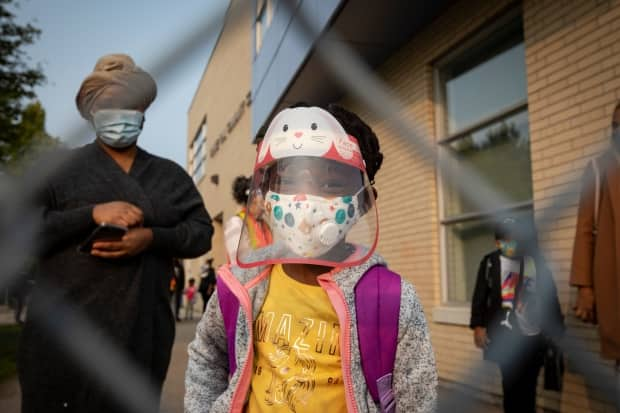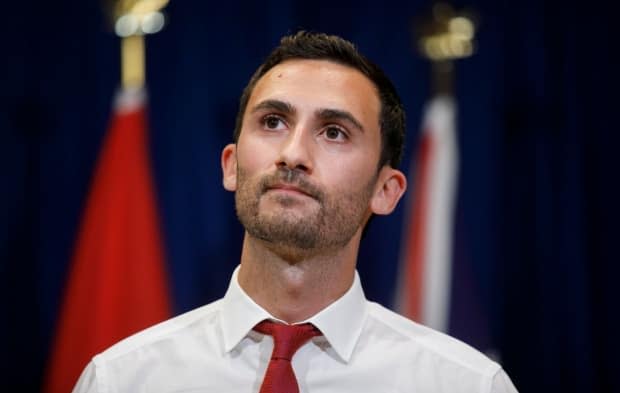Ontario to allow 'high-contact indoor sports' for students, won't mandate vaccines

Ontario will allow students to participate in "high-contact indoor sports" like basketball and hockey when the school year resumes, the education minister said Wednesday, and the province still has no intention to mandate COVID-19 vaccinations for educators, staff or students.
Stephen Lecce said the provincial government will continue to advocate for its immunization campaign, but a mandate is not on the table "at this point."
Dr. Kieran Moore, Ontario's chief medical officer of health, said that he'd like to see as much as 90 per cent of eligible Ontarians fully vaccinated. As of yesterday, more than 70 of those aged 12 and older had had both shots, while more than 80 per cent had at least one dose.
Moore stressed that vaccinations are key to maintain a low rate of community infection, which in turn will keep schools safe, he said.

Lecce and Moore made the comments at a morning news conference to announce a $25-million commitment to help school boards procure 20,000 additional high-efficiency particulate air (HEPA) filters before the academic year begins.
All kindergarten classrooms will be equipped with standalone HEPA units, Lecce said, regardless of whether the school already has mechanical ventilation. Junior and senior kindergaten students will not be required to wear masks while in class under the new guidelines.
With the 50,000 or so HEPA units already in schools provincewide, the money will help ensure that all learning spaces, including libraries and gymnasiums, that are not already mechanically ventilated, will have a HEPA unit when students return, Lecce said.
The decision that high-contact indoor sports can resume was a reversal from the guidance included in Ontario's newest back-to-school plan, which was released on Tuesday afternoon — five weeks out from the start of classes for most Ontario schools.
Moore said that with a combination of screening, quick access to testing and high vaccination rates, "it is reasonable to allow" those activities to restart this year.
Meanwhile, other extracurricular activities can resume, and there will be relaxed rules on using shared spaces like libraries and cafeterias, where cohorts will be able to eat together. Students in Grades 1 and up will be required to wear masks while indoors.
Students will be attending in person for full days, five days a week — unless they have opted for remote learning — and high school students will have timetables with no more than two courses at a time.
The plan makes no mention of reduced class sizes or the use of rapid antigen tests for asymptomatic students.
Moore said that given the currently low rate of infection in the wider community, there is a significant risk of rapid tests producing false positives.
After consulting with Public Health Ontario and local health units, there was consensus that deploying rapid tests in schools would be "too burdensome" and "too cumbersome to implement," Moore said.

The 29-page document is also thin on details about how schools will manage COVID-19 cases and outbreaks, however. The document suggests more guidance will be coming soon.
Its release was met with cautious optimism by some educators and medical professionals, while others said it lacks critical information, such as the conditions that would necessitate temporarily closing a school to in-person learning.
Dr. Kashif Pirzada, an emergency physician at Humber River and Sunnybrook hospitals in Toronto and founder of the group Masks 4 Canada, said he would grade the government's plan as a "solid C+ or B-".
Pirzada said it compares favourably to what other provinces have proposed but is missing critical details about testing and outbreak management that could be key if there's a fourth wave driven by the highly infectious delta variant.
He added that, in his opinion, it puts too much emphasis on "hygiene theatre" — such as regular disinfection of shared surfaces — when there is consensus that airborne transmission of the virus poses a far greater threat.
139 new cases of COVID-19
Meanwhile, Ontario reported another 139 cases of COVID-19 this morning.
It also logged the deaths of 11 more people with the virus. A spokesperson for the Ministry of Health said that seven of those deaths occurred between December 2020 and February 2021, and were included in today's update due to a data clean up by Public Health Ontario.
Here are some other key pandemic indicators and figures from the ministry's daily provincial report:
Seven-day average of daily cases: 199, down from 201 yesterday
Tests completed: 17,115
Provincewide test positivity rate: 1.2 per cent
Current number of active cases: 1,690
Patients in ICU with COVID-related illnesses: 108 as of Tuesday evening; 76 needed a ventilator to breathe
Death toll: 9,360
Vaccinations progress: 60,094, the fewest shots administered on a Tuesday since March 16. Roughly 70.6 per cent of Ontarians aged 12 and older have had two doses.
Ontario: New daily cases of COVID-19

 Yahoo Movies
Yahoo Movies 